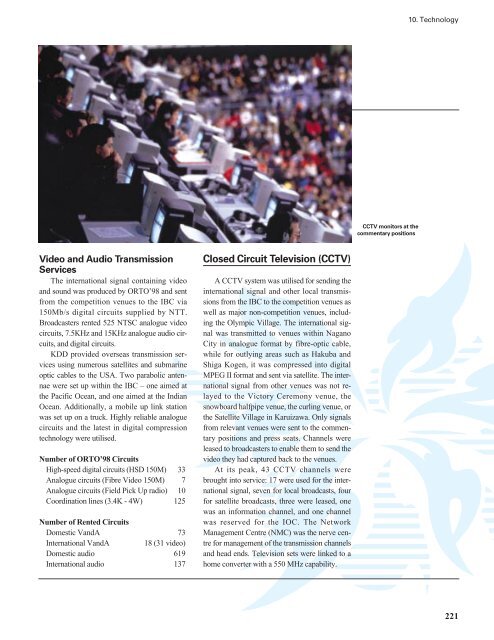107th IOC Session - LA84 Foundation
107th IOC Session - LA84 Foundation
107th IOC Session - LA84 Foundation
Create successful ePaper yourself
Turn your PDF publications into a flip-book with our unique Google optimized e-Paper software.
Video and Audio Transmission<br />
Services<br />
The international signal containing video<br />
and sound was produced by ORTO’98 and sent<br />
from the competition venues to the IBC via<br />
150Mb/s digital circuits supplied by NTT.<br />
Broadcasters rented 525 NTSC analogue video<br />
circuits, 7.5KHz and 15KHz analogue audio circuits,<br />
and digital circuits.<br />
KDD provided overseas transmission services<br />
using numerous satellites and submarine<br />
optic cables to the USA. Two parabolic antennae<br />
were set up within the IBC – one aimed at<br />
the Pacific Ocean, and one aimed at the Indian<br />
Ocean. Additionally, a mobile up link station<br />
was set up on a truck. Highly reliable analogue<br />
circuits and the latest in digital compression<br />
technology were utilised.<br />
Number of ORTO’98 Circuits<br />
High-speed digital circuits (HSD 150M) 33<br />
Analogue circuits (Fibre Video 150M) 7<br />
Analogue circuits (Field Pick Up radio) 10<br />
Coordination lines (3.4K - 4W) 125<br />
Number of Rented Circuits<br />
Domestic VandA 73<br />
International VandA 18 (31 video)<br />
Domestic audio 619<br />
International audio 137<br />
Closed Circuit Television (CCTV)<br />
A CCTV system was utilised for sending the<br />
international signal and other local transmissions<br />
from the IBC to the competition venues as<br />
well as major non-competition venues, including<br />
the Olympic Village. The international signal<br />
was transmitted to venues within Nagano<br />
City in analogue format by fibre-optic cable,<br />
while for outlying areas such as Hakuba and<br />
Shiga Kogen, it was compressed into digital<br />
MPEG II format and sent via satellite. The international<br />
signal from other venues was not relayed<br />
to the Victory Ceremony venue, the<br />
snowboard halfpipe venue, the curling venue, or<br />
the Satellite Village in Karuizawa. Only signals<br />
from relevant venues were sent to the commentary<br />
positions and press seats. Channels were<br />
leased to broadcasters to enable them to send the<br />
video they had captured back to the venues.<br />
At its peak, 43 CCTV channels were<br />
brought into service: 17 were used for the international<br />
signal, seven for local broadcasts, four<br />
for satellite broadcasts, three were leased, one<br />
was an information channel, and one channel<br />
was reserved for the <strong>IOC</strong>. The Network<br />
Management Centre (NMC) was the nerve centre<br />
for management of the transmission channels<br />
and head ends. Television sets were linked to a<br />
home converter with a 550 MHz capability.<br />
CCTV monitors at the<br />
commentary positions<br />
10. Technology<br />
221
















